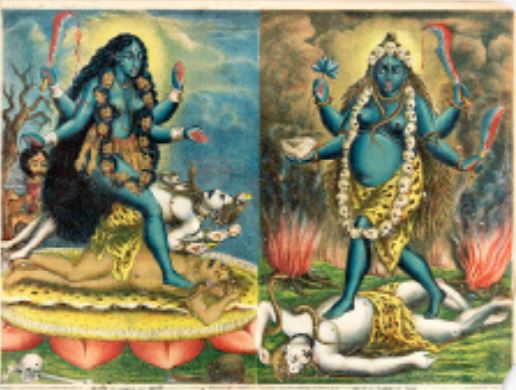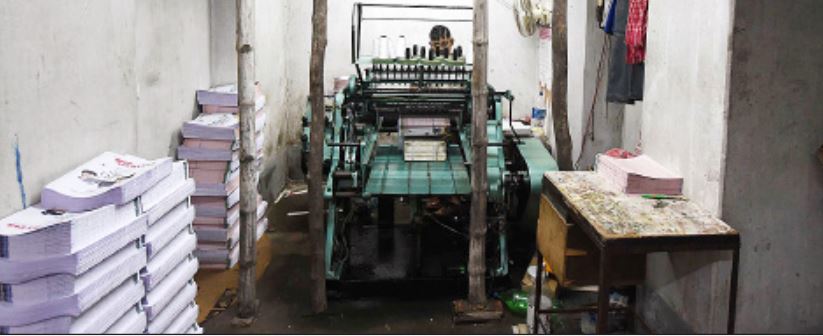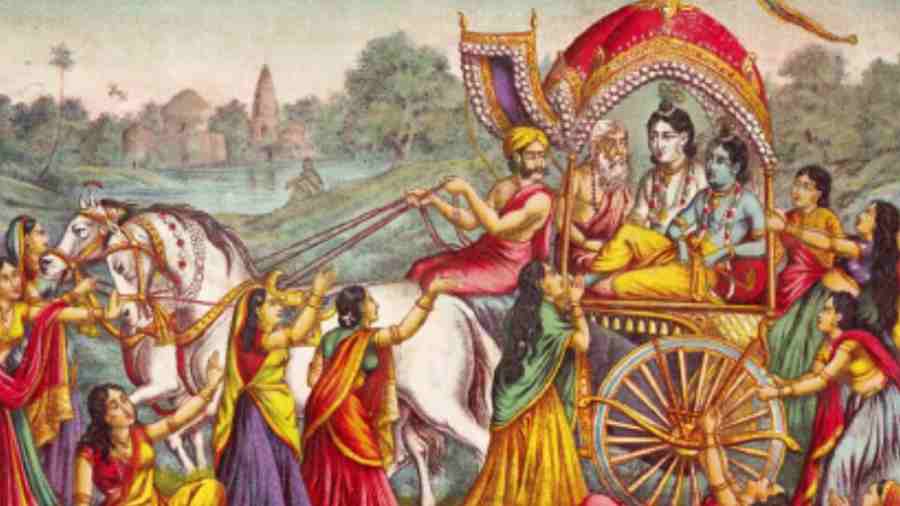A studio that has produced many rare illustrations, some of them part of the archives of leading museums of the world, has been damaged by the October 14 accident in the East-West Metro tunnel in Bowbazar in central Kolkata.
Calcutta Art Studio, a 144-year-old institution, stands on 185/1A BB Ganguly Street. Right across the road is the entrance to Madan Dutta Lane, the site of the accident.
The two-storey building that houses the studio has developed several cracks, some of them getting wider with time.
When the studio began in 1878, it sold pictures of Hindu gods and goddesses. Within a few years, it started producing lithographic illustrations of deities and luminaries of the time. They were colourful pictures printed from drawings by in-house artists.
Before the unit had a sophisticated machine, some of the pictures were sent to Germany for printing.
Now, the studio functions as a full-fledged press, printing diaries, calendars and the like.

A colourful lithographic illustration in the collection of the Metropolitan Museum of Art in New York. The Met website says the work dates back to “1885-90”. The illustration has two parts. On the left is Kali and on the right, Tara
Pictures courtesy: Metropolitan Museum of Art, British Museum and Calcutta Art StudioOn Wednesday, The Telegraph saw over a dozen cracks in the building. The cracks were on the floors, walls and the roof on the ground and first floors.
Over 30 steel, wood and bamboo props stood on the ground floor as temporary insurance.
“We have set up some. The remaining props have been put up by the Metro authorities. But the building needs urgent repair work. Metro officials have been visiting regularly. But the only repair they have done till now is fixing the damaged water reservoir. The repair of the building is yet to start,” said Shubhojit Biswas, one of the directors of the family-owned business.

A lithograph of ‘Maharshi’ Debendranath Tagore, the eldest son of industrialist and reformer ‘Prince’ Dwarakanath Tagore, and a founder of the Brahmo movement. The work, which Biswas said dated back to the late 19th century, is preserved at the studio
Pictures courtesy: Metropolitan Museum of Art, British Museum and Calcutta Art StudioCracks appeared in around a dozen houses in the Bowbazar area following water seepage during construction of a passage to connect the two tunnels of East-West Metro on October 14.
In the early hours of October 15, the cracks were first spotted by staff who live in the studio. Since then, some of the cracks have widened, keeping the owners and the workers on tenterhooks.
One of the cracks on a wall behind the staircase started from the ground floor and went up to the ceiling.
“I have done some urgent repair on my own. I have urged the Metro authorities to provide the material so that I can start the remaining work myself. But they are yet to get back on the proposal,” said Biswas.

Props put up on the ground floor of Calcutta Art Studio on 185/1A BB Ganguly Street in Bowbazar; (left) a cracked wall at the studio.
Gautam BoseDespite the cracks, work was on in full swing. November is peak season for printers, mainly on account of year-end items like calendars and diaries.
The studio was started by Annadaprasad Bagchi, a 19th-century artist, and four of his students.
By 1920, three others also left and the studio was left in the hands of the remaining founder, Naboo Coomar Biswas, the great-grandfather of Shubhojit.
In the late 19th century, Calcutta Art Studio emerged as a leading producer of lithographic prints.

The Metropolitan Museum of Art in New York and the British Museum in London are among the destinations of some of the works produced by Calcutta Art Studio.
The lithographic illustration in the Met collection, which dates back to “1885-90” has two subjects — Kali and Tara, two different forms of Shakti.
“Two scenes occupy the sheet, on the left the fearful four-armed Kali, wearing a skirt of severed arms and garlanded with severed heads, standing astride two appearances of Shiva, one brownskinned corpse-like and the second, white-skinned.... The right side of the composition is occupied by Tara and appears much like Kali, with a diadem and garland of skulls and Shiva’s tiger skin worn around her waist. She also tramples a prone Shiva, here lying amidst a charnel ground with blazing pyres,” says the description on the Met website.
Another illustration of Krisha and Balarama is part of the British Museum.
“Krishna and Balarama are seated in a chariot driven by Akrura. They are leaving their home of Brindaban and travelling to Mathura to fight Krishna’s uncle Kamsa.
The gopis crowd around the chariot, clutching at the wheels, attempting to halt their departure,” says the description on the British Museum website. The picture dates back to 1895. Closer home, the Indian Museum and Victoria Memorial also have the studio’s lithographic prints in their collections.
“We have over 50 exhibits from Calcutta Art Studio,” said an official of Victoria Memorial. The studio still retains several old pictures. Biswas said so far, they were safe but he was not sure of the future. “When the tunneling work resumes, there is no guarantee that a bigger accident will not happen. I am worried about the safety of the collection,” he said.
An engineer of KMRC, the implementing agency of East West Metro, who visited the studio, said the house would be repaired soon. “We are following a schedule. We have repaired adjacent buildings and this one will also be repaired. The damage is not extensive,” he said.






